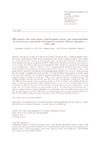Identificador persistente para citar o vincular este elemento:
https://accedacris.ulpgc.es/jspui/handle/10553/77932
| Título: | Milk somatic cell count, lactate dehydrogenase activity, and immunoglobulin G concentration associated with mastitis caused by different pathogens: A field study | Autores/as: | Hernández Castellano, Lorenzo Enrique Wall, S Stephan, R Corti, S Bruckmaier, R |
Clasificación UNESCO: | 3104 Producción Animal | Palabras clave: | Immunglobulin G Laktatdehydrogenase Mastitis Somatische Zellzahl Immunoglobulin G, lactate dehydrogenase, et al. |
Fecha de publicación: | 2017 | Publicación seriada: | Schweizer Archiv für Tierheilkunde | Resumen: | The aim of this study is to analyze how somatic cell counts (SCC), immunoglobulin G (IgG), and lactate dehydrogenase (LDH) interact dependent on the mastitis causing pathogen. Milk samples from 152 quarters were collected on 2 Swiss dairy farms equipped with automatic milking systems. Bacteriological culturing was performed and SCC, LDH activity and IgG concentrations were measured in each sample. Correlations and regressions among SCC, LHD, and IgG were calculated after grouping by the pathogen type (control, S. aureus, C. bovis, coagulase-negative Staphylococcus and S. uberis). All the mastitis causing pathogens were gram-positive bacteria (except for 3 cases with E. coli). In this study, the SCC and LDH were affected by the pathogen group. However, only in the S. uberis group the IgG concentration was higher than in the controls. All studied variables were positively correlated among each other. SCC and LDH were the highest correlated parameters in the control, S. aureus, C. bovis and coagulase- negative Staphylococcus groups. Only in the S. uberis group the correlation between LDH and IgG was higher than the correlation between SCC and LDH. The regression coefficients for SCC and LDH differed between groups whereas regression coefficients for SCC and IgG, and for LDH and IgG were similar in all groups. Because cases with E. coli infection were so rare, we could not include these cases in the statistical evaluation. Based on these few cases E. coli (n=3) seemed to cause a much higher increase of IgG and LDH than the infection with gram-positive bacteria. This study shows that the suitability of LDH as a marker for IgG transfer is dependent on the pathogen. The use of LDH in combination with SCC may be used as a marker to differentiate between gram-positive and gram-negative bacteria, but does not allow differentiating the immune response between different gram-positive bacteria. | URI: | https://accedacris.ulpgc.es/handle/10553/77932 | ISSN: | 0036-7281 | DOI: | 10.17236/sat00115 | Fuente: | Schweizer Archiv für Tierheilkunde [ISSN 0036-7281], v. 159(5), p. 283-290 |
| Colección: | Artículos |
Citas de WEB OF SCIENCETM
Citations
30
actualizado el 08-jun-2025
Visitas
177
actualizado el 14-sep-2024
Descargas
189
actualizado el 14-sep-2024
Google ScholarTM
Verifica
Altmetric
Comparte
Exporta metadatos
Los elementos en ULPGC accedaCRIS están protegidos por derechos de autor con todos los derechos reservados, a menos que se indique lo contrario.
